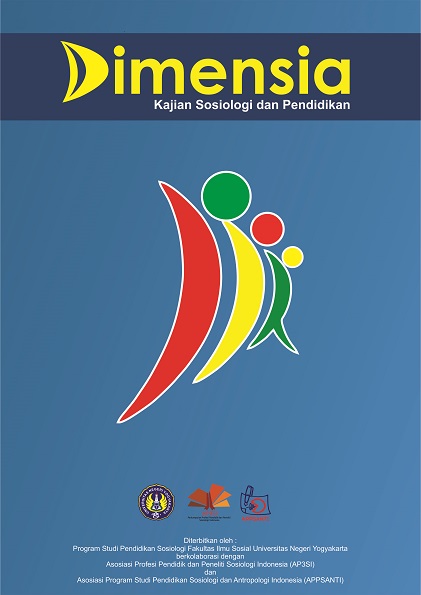SKATEBOARD, SUBCULTURE, AND INDUSTRY: A STUDY ABOUT YOUNG SKATE WORKERS IN INDONESIA
DOI:
https://doi.org/10.21831/dimensia.v11i1.59123Keywords:
Skateboard, Cabang Kebudayaan, Budaya Anak Muda, Pekerja, OlahragaAbstract
Artikel ini merupakan analisis tekstual skateboard sebagai subkultur dan peluang kerja bagi anak muda di Indonesia, yang menyajikan eksplorasi strategi mereka untuk meraih karir di industri skateboard. Penelitian ini menggunakan metode kualitatif dengan pendekatan analisis tekstual yang dilaksanakan selama tiga bulan. Penelitian ini melibatkan tiga informan utama dari anak muda yang berprestasi pada kompetisi skateboard nasional dan/atau internasional dan mendapatkan pekerjaan dari sponsor skateboard. Temuan penelitian ini menunjukkan bahwa pemaknaan skateboard sebagai subkultur telah berkembang, di mana anak muda tidak hanya melihat skateboard sebagai bentuk aktualisasi diri, tetapi juga sebagai ruang di mana mereka dapat mengembangkan bakat dan memenuhi kebutuhan mereka melalui kolaborasi dengan sponsor. Di Indonesia, skateboard menjadi salah satu kegiatan yang mendapat pengakuan dari pemerintah, hal ini terlihat dari upaya pemerintah Indonesia selaku tuan rumah Asian Games 2018 (Jakarta-Palembang) yang mendaftarkan skateboard sebagai salah satu cabang olahraga yang dipertandingkan dalam ajang tersebut. Dukungan pemerintah Indonesia terhadap olahraga skateboard juga diikuti dengan pembangunan fasilitas skate park di beberapa kota di Indonesia.
References
Allen, M. (2017). The SAGE Encyclopedia of Communication Research Methods. SAGE Publications, Inc. https://doi.org/10.4135/9781483381411
Beal, B. (2019). Skateboarding LA: Inside Professional Street Skateboarding. Contemporary Sociology, 48(3), 352–354. https://doi.org/10.1177/0094306119842138pp
Beal, B., & Weidman, L. (2003). Authenticity in the Skateboarding World. Faculty Publications. https://digitalcommons.linfield.edu/mscmfac_pubs/10
Buckingham, D. (2009). Skate Perception: Self-Representation, Identity and Visual Style in a Youth Subculture. Video Cultures, 133–151.
Deluccia, T. (2015, September 28). No Skateboarding Signs and 8 Other Examples of Bad Non-Verbal Church Communication. TonyMorganLive.Com. https://tonymorganlive.com/2015/09/28/no-skateboarding-signs-and-8-other-examples-of-bad-non-verbal-church-communication/
Donnelly, M. (2008). Alternative and mainstream: Revisiting the sociological analysis of skateboarding. Tribal Play: Subcultural Journeys Through Sport, 197–214. https://doi.org/10.1016/S1476-2854(07)00208-7
Geckle, B., & Shaw, S. (2022). Failure and Futurity: The Transformative Potential of Queer Skateboarding. YOUNG, 30(2), 132–148. https://doi.org/10.1177/1103308820945100
Global View Research. (2019). Skateboard Market Size, Share: Industry Trends Report, 2019-2025. https://www.grandviewresearch.com/industry-analysis/skateboard-market
Guinness World Records. (1973). First polyurethane skateboard wheel. Guinness World Records. https://www.guinnessworldrecords.com/world-records/107006-first-polyurethane-skateboard-wheel
Haenfler, R. (2012). Goths, Gamers, & Grrrls: Deviance and Youth Subcultures (2nd edition). Oxford University Press.
Haenfler, R. (2013). Subcultures: The Basics. https://doi.org/10.4324/9781315888514
Hall, S., & Jefferson, T. (Ed.). (2006). Resistance Through Rituals: Youth Subcultures in Post-War Britain (2nd edition). Routledge.
Hartleib, C., & Hartleib, K. (2021). History of Skateboarding | skatedeluxe Blog. https://www.skatedeluxe.com/blog/en/wiki/skateboarding/history-of-skateboarding/
Johnston, D. (2016). Skateparks: Trace and culture. Global Media Journal: Australian Edition. https://researchdirect.westernsydney.edu.au/islandora/object/uws%3A45561/
Kumparan. (2018). Rubianda Rachman, Miliki Segudang Prestasi sejak Dini. kumparan. https://kumparan.com/millennial/rubianda-rachman-miliki-segudang-prestasi-sejak-dini-21dM5TZJ5j
Li, C. (2022). Cultural Continuities and Skateboarding in Transition: In the Case of China's Skateboarding Culture and Industry. YOUNG, 30(2), 183–206. https://doi.org/10.1177/11033088221081941
Miller, C. (2021, April 19). How TikTok And Skater Girls Are Sending Skateboard Sales Off The Wall. NPR. https://www.npr.org/2021/04/19/986527276/how-tiktok-and-skater-girls-are-sending-skateboard-sales-off-the-wall
Moran, I. (2010). Punk: The Do-It-Yourself Subculture. undefined. https://www.semanticscholar.org/paper/Punk%3A-The-Do-It-Yourself-Subculture-Moran/bf18c0f5ea7f51d9c6b975994d77b01bac82a474
O'Connor, P. (2016). Skateboarding, Helmets, and Control: Observations From Skateboard Media and a Hong Kong Skatepark. Journal of Sport and Social Issues, 40(6), 477–498.
O'Connor, P. (2018a). Beyond the youth culture: Understanding middle-aged skateboarders through temporal capital. International Review for the Sociology of Sport, 53(8), 924–943.
O'Connor, P. (2018b). Hong Kong Skateboarding and Network Capital. Journal of Sport and Social Issues, 42(6), 419–436.
Olivo, M. (2015, Maret 18). The Skater Subculture: Its Representations and Misrepresentations. Skaters. https://skatersubculture.wordpress.com/2015/03/18/the-skater-subculture-its-representations-and-misrepresentations/
Radikonyana, P. S., Prinsloo, J. J., & Pelser, T. (2017). The contribution of skateboarding to societal challenges. African Journal of Hospitality, Tourism and Leisure, 6, 1–20.
Ross, H. (2017). Skaters – Subcultures and Sociology. https://haenfler.sites.grinnell.edu/subcultures-and-scenes/skater-subculture/
Roth, E. (2004). Dogtown and Z Boys (review). Journal of American Folklore, 117(464), 197–198. https://doi.org/10.1353/jaf.2004.0062
SHOF. (2012). Frank Nasworthy – 2012 – Skateboarding Hall of Fame and Museum. https://skateboardinghalloffame.org/2020/04/frank-nasworthy-2012/
Snyder, G. J. (2012). The city and the subculture career: Professional street skateboarding in LA. Ethnography, 13(3), 306–329. https://doi.org/10.1177/1466138111413501
Theluxmag. (2021, Agustus 8). Why Skateboarding is Still Popular in 2021"”The Luxury Magazine. https://theluxmag.com/why-skateboarding-is-still-popular-in-2021/
Thurnell-Read, T. (2021). "˜A Couple of These Videos Is All You Really Needed to Get Pumped to Skate': Subcultural Media, Nostalgia and Re-Viewing 1990s Skate Media on YouTube. YOUNG, 110330882110573. https://doi.org/10.1177/11033088211057365
Vivoni, F. (2009). Spots of Spatial Desire: Skateparks, Skateplazas, and Urban Politics. Journal of Sport and Social Issues, 33(2), 130–149. https://doi.org/10.1177/0193723509332580
Yochim, E. C. (2010). Skate Life: Re-Imagining White Masculinity. University of Michigan Press. https://doi.org/10.2307/j.ctv65sw5s
Zach, & David. (2021). The Skateboarding Industry. DIVERTsessions. https://www.divertsessions.com/blogs/news/the-skateboarding-industry
Downloads
Published
How to Cite
Issue
Section
License
Penulis yang menerbitkan jurnal ini menyetujui ketentuan berikut:
- Penulis memegang hak cipta dan memberikan hak publikasi pertama kepada jurnal dengan karya tersebut secara bersamaan dilisensikan di bawah Lisensi Atribusi Creative Commons yang memungkinkan orang lain untuk berbagi karya dengan pengakuan atas kepenulisan karya dan publikasi awal di jurnal ini.
- Penulis dapat mengadakan perjanjian kontrak tambahan yang terpisah untuk distribusi non-eksklusif dari karya versi terbitan jurnal (misalnya, mempostingnya ke repositori institusi atau menerbitkannya dalam buku), dengan pengakuan atas publikasi awalnya pada tahun jurnal ini.
- Penulis diizinkan dan didorong untuk memposting karya mereka secara online (misalnya, di repositori institusi atau di situs web mereka) sebelum dan selama proses penyerahan, karena hal ini dapat mengarah pada pertukaran yang produktif, serta kutipan karya yang diterbitkan lebih awal dan lebih banyak (Lihat The Pengaruh Akses Terbuka).
====================================================
Authors who publish with this journal agree to the following terms:
- Authors retain copyright and grant the journal right of first publication with the work simultaneously licensed under a Creative Commons Attribution License that allows others to share the work with an acknowledgement of the work's authorship and initial publication in this journal.
- Authors are able to enter into separate, additional contractual arrangements for the non-exclusive distribution of the journal's published version of the work (e.g., post it to an institutional repository or publish it in a book), with an acknowledgement of its initial publication in this journal.
- Authors are permitted and encouraged to post their work online (e.g., in institutional repositories or on their website) prior to and during the submission process, as it can lead to productive exchanges, as well as earlier and greater citation of published work (See The Effect of Open Access).








